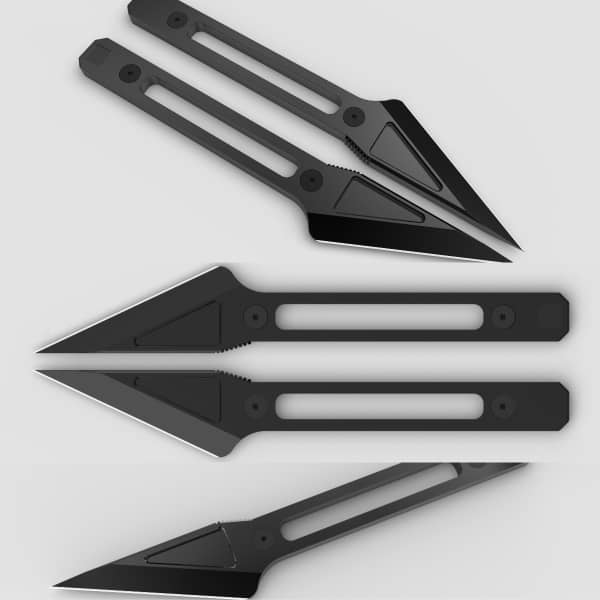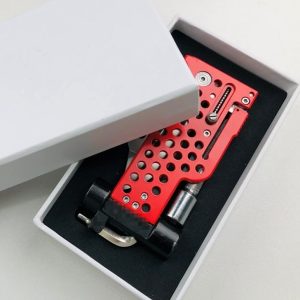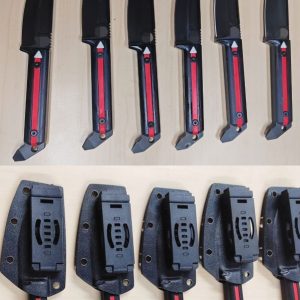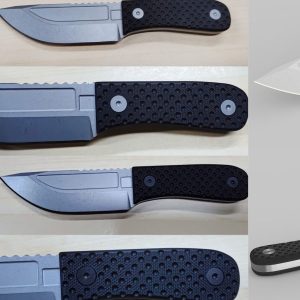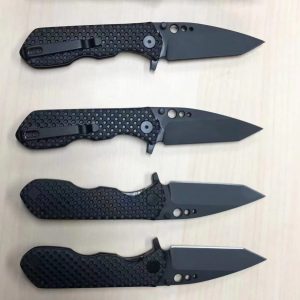Part 1 – Project Overview
Lead Time
This project was not overly demanding, taking a total of six months to complete.
Shieldon(an OEM manufacturer) professionals had to wait one month for components from the client’s country, another month for prototyping and adjustment followed by two months of production before they were finished – all while keeping in mind the Chinese long vacation period!
Shieldon’s average lead time for fixed knife orders is approximately 4-5 months from start to finish.
This period closely follows the production schedule, making it ideal for predictable delivery times.
How the project came
The buyer had been able to source handles and screws for his product in his nation, yet hit a roadblock when he was unable to locate any factory that could manufacture the blade.
After searching high and low through Google search, he eventually found Shieldon – the perfect solution!
When comparing numerous international factories, Shieldon’s extensive knife-making experience ultimately convinced his decision.
Astonishingly, the customer was unconcerned about matching scales during production as the specialists were worried that components from different facilities could be incongruent with each other.
After some back-and-forth correspondence between him and the professionals at Shieldon, they agreed to take on this risky endeavor without hesitation.
Products purchase
Neckie knife
- Blade material: CPM-3V
- Handle material: null
- Blade HRC: 60-62
- Sharpened angle: 20-25 angle (one-side)
- Blade thickness: confidential
- Blade length: confidential
- Handle thickness: null
- Total length : confidential
- Weight: confidential
- Assembly hardware: null
- Carry orientation: Both hands
- Blade style: American tanto point
- Handle color: Black
- Blade finish: Diamond-like coating
- Blade grind: Flat
- Clip: null
Sheath
- Material: Kydex
- Size (mm): confidential
- Size (inch): confidential
- Eyelet: confidential
- Structure: stacked
- Clip: not
- Carry orientation: ambidextrous
- Pairing: 1 sheath for 1 neckie knife
Part 2 – Reasons why customers chose us
Supplied 3D file modification and rendering of images
It was a custom-made neckie knife that didn’t have a scale or a screw.
The customer gave Shieldon a 3D file, which they had to change so that it could be made in real life, and then they rendered pictures to make sure.
The customer’s 3D file helped the Shieldon team understand how he wanted his neckie knife to work and gave them a way to quickly finish the first drawing.
The drawing didn’t take too long for professionals, and they could reply quickly to questions about costs.
Supplied steel option
Shieldon provides an advantageous comparison system with four indicators for 37 distinct sheets of steel: hardness, edge retention, wear resistance, and corrosion resistance.
With the convenient method of comparing all these elements side by side, one can easily make the perfect choice for their specific needs!
By analyzing the numbers presented in these performance indicators, they can determine which steel is superior for a specific purpose.
After examining the quantitative data, it was clear that no single steel had an uncontested advantage.
Shieldon can identify and explain why certain steels are preferable based on their advantages and disadvantages.
Since crucible steels have grown in popularity among knife users, they chose CPM-3V steel for the customer’s neckie knife.
Supplied K-sheath designing and making
The neckie knife required a K-sheath because its point was too pointed and could cause injury if not secured.
Shieldon assisted with the planning and fabrication, which resulted in the customer’s ideas being put into action. The small K-sheath protects the blade tip.
Shieldon provided Packaging
Packaging is an integral element when shipping goods.
Shieldon was aware that the customer did not require an intricate package case, so they invested minimal effort in crafting one; an austere Kraft case accompanied by a PP bag sufficed for transporting the necktie knife.
Despite this, when it arrived at its destination, some assembly of scales was still necessary by the recipient.
Shieldon provided Shipping
The majority of Shieldon’s OEM customers weren’t aware of or have the resources to handle shipping and customs clearance.
Because Shieldon offers a comprehensive service, from sketch drawing to final delivery, they are not only able to provide quality knives but can also arrange for shipments after production is complete.
OEM customers can rest easy knowing that Shieldon provides a one-stop service so all they have to do is wait for the goods to arrive.
The team’s sophisticated OEM process has enabled them to create relationships of trust with their overseas clients and gain more orders as a result.
Part 3 – Story of Manufacturing Process
Initially, the customer provided me with an “SLDPRT” extent file.
After Shieldon signed an NDA and opened the file, they discovered that it included all of its dimensions—including screw placement diameter and concave-convex depth—in addition to its well-structured design.
The design of the fixed knife was not complex, and its dimensions were straightforward enough for us to envisage.
Still, the team needed to alter it somewhat to make it feasible with present-day technology. In this way, it could ensure that Shieldon’s vision became a physical reality.
Shieldon observed that the neckie knife had two screw openings, and the client needed to use his screws to repair the scales.
The scales and fasteners were both in his possession, so the team had to ask him to give them some samples and let my team measure the dimensions of the components so that the shape that could match the existing components could be simpler to figure out.
The draft neckie knife was too broad and needed to be trimmed up.
Shieldon reduced the neckie knife’s breadth slightly due to a covert team consideration to secure the components in the customers’ hands.
To ensure a secure attachment of the screws, Shieldon slimmed down the width slightly.
When it came to the screw hole, they understood that Chicago-style hex-head flat socket screws were needed.
Yet, for it to thread into the neckie knife correctly, Shieldon had to make adjustments so that the screws could be inserted deeply within the tang and aligned with its scales.
The team was able to carefully measure and determine the precise size of the product by having scales and screws on hand.
When they presented their findings in a structural image to the customer, he was delighted that Shieldon had been able to tailor it according to his components.
After the picture was completed, here were the modeling photos of the neckie knife.
The screw hole was designed for the customer’s Chicago-style screws, the empty spot in the tang was for weight reduction, and the larger near the point was for anti-sticking or specific use.
Please take note of the rectangle on the handle.
This was used to place a QR code.
What a creative notion the client has! When customers read the number, he expects they will get the item’s specifications. The algorithm was still in development.
The modeling pictures with Chicago-style fasteners are shown below.
Shieldon created the pictures one by one to ensure that each stage was completed properly and sent them to the client for further approval.
The team was extra careful because the fasteners, and even the handle weights, were not manufactured by Shieldon.
According to past experience, it is possible that two components were not manufactured in the same plant or even in the same nation.
Shieldon’s employees did not want to void the neckie knife because the actual fasteners or handle sizes did not match.
The neckie knife was not difficult to create because it did not require any complex techniques or mechanisms, but the team was concerned that the silhouette would not match the actual components.
Shieldon went on to illustrate the entire object with fasteners and handle sizes after the client approved the screw modeling.
The crew only needed to produce the neckie blades, but they were serious about each job.
After seeing the finished modeling pictures, the client agreed to pay for the testing.
Shieldon typically uses the Alibaba payment network for testing and payment of delivery costs.
It is a global commerce network that ensures both customers and sellers, even if they are from different countries.
The medium has seen extensive use in foreign trade.
A payment link was promptly generated and made available to the specified recipient, and the payment can be completed simply online using a credit card.
This is extremely useful for foreign company payments. After receiving money from the client, the team began the testing process.
Here’s a look at the neckie knife designs.
Shieldon could see that it had not yet been finished in black titanium, that the jimping on the spine had not yet been made, and that the blade had not yet been honed.
Shieldon tested on hand first to see if the actual fasteners and handle scales could be matched to the neckie knife properly.
Fortunately, as shown in the picture, the neckie knife suited perfectly.
However, when the prototype was created, the Shieldon crew discovered an issue.
Shieldon specialists discovered that it was dense across the breadth of the knife, making honing challenging.
Because the overall dimension was too large, the team discovered that there wasn’t enough room to mill the angle “V” form thoroughly, so the crew couldn’t make the border precise enough.
Shieldon’s employees inquired about the customer’s preferred level of sharpness. The response was that the finer the edge, the better.
This was the thickest knife Shieldon had ever manufactured.
The heavy body made sharpening the edge difficult because there was insufficient room for thorough honing.
The expert staff met with the engineers in the studio to collaborate on a plan.
The specialists had two choices at the time, but neither was satisfactory.
The first option was to mill the blade as much as possible, but this would remove the finish on the blade surface; the second option was to continue with regular honing and let the edge be as keen as it could be.
Option one:
To keep the knife all black, Shieldon polished both sides of the blade at an angle.
The result was a stunning black titanium coating with hand-sharpened edges.
Unfortunately, due to the thickness of the blade after two rounds of polishing, it was too small for reducing its angle and therefore made its edge appear less sharp than anticipated.
Option two:
Shieldon engineered a black titanium coating to sharpen the edge, then used precision polishing on both sides of the edge for an even sharper finish.
Unfortunately, some of this protective layer was lost in the process but Shieldon ultimately achieved desired results.
At that moment, the team proposed option two- making a black knife with sharp edges.
Unfortunately, this proved to be difficult due to the blade’s thickness; Shieldon knew they had to find an alternate way and promised that they would inform their customer shortly.
Not only was it impossible for them to make such a thick neckie knife but sourcing steel of such specific thicknesses was also rare and hard work.
Shieldon recommended using option two to create the neckie because the client requested it to be as pointed as feasible.
However, the client did not accept this method due to its unappealing look.
Another minor problem was the positioning of the QR code.
The crew was unsure of the extent of the QR code depth because Shieldon did not have a code on hand. They kept asking if they needed to change the size of the square.
Shieldon was working on the K-sheath design while they were pondering the sharpening method.
To begin, the team requested the client a general concept of how to create the K-sheath, such as which hue, form, height, or whether a fastener was required.
Shieldon specialists used to demonstrate to clients a few samples and tell them they could create K-sheaths like these.
They began to create a skeletal picture for client validation after having a short concept after much back and forth.
Shieldon engineers created two neckie knife versions based on traditional K-sheaths for comparison.
The distinction between these two styles was that the one on the left concealed a portion of the handle, whereas the one on the right did not.
Manufacturing a knife is not the same as manufacturing a K-sheath.
Aside from producing shaping sets, the form of the K-sheath must suit the associated knife, so an actual knife is used when making the K-sheath; otherwise, the angle or dimension may not fit, resulting in the K-sheath not holding the knife securely.
Furthermore, the eyelet in the K-sheath served as both ornamentation and utility.
Shieldon used a real sample neckie knife to create a K-sheath prototype after verifying the size and form, and they were planning to ship several sets to the client for testing.
Despite the K-sheath design being relatively straightforward, Shieldon’s team did not anticipate an issue while they worked diligently to complete their prototypes in just 7 days.
Nevertheless, they ultimately persevered and were able to finish building each item one by one.
Shieldon realized that the K-sheath was not able to fit their neckie knife snugly after they affixed handle scales on it.
The extra bulk of the handles had made the mouth of the sheath too small for insertion.
Consequently, they proposed a redesign of the K-sheath to accommodate this issue.
As shown in the image, Shieldon highlighted in red and urged the customer to widen K-sheath’s opening for their neckie knife handle scales to fit properly.
Fortunately, Shieldon remained steadfast in their communication with the customer – he explained that there were several variations of scales with varying sizes.
To guarantee all handle scales could fit comfortably within the K-sheath, Shieldon expanded the mouth size according to the maximum size measurement of each scale.
https://youtube.com/shorts/vKW0rvJtZjo
As seen by the video, Shieldon’s K-sheath fitted perfectly on neckie knives with handle scales – no matter how much it shook, it stayed firmly attached.
It is clear that not only does Shieldon make its knives with utmost care and precision but all of their corresponding components as well.
The customer was very pleased to have been able to work alongside them in creating such a memorable product.
When it came to the neckie knife, the customer was uncertain of what kind of steel they should select.
Shieldon provided a helpful comparison system that helped them decide on CPM-3V Steel.
This specific steel met all four criteria such as thickness and durability compared to CPM-154 and CPM-S35VN steels.
Shieldon expounded to the customer that CPM 3V is a robust, resilient tool steel made through the Crucible Particle Metallurgy process.
This steel offers superior durability and resistance to breakage and chipping, exceeding the impact strength of A2, D2, Cru-Wear, or CPM M4 material.
It comes close to matching the shock-resistant capacities seen in S7 – making this an excellent choice for hardwearing projects.
CPM 3V is designed to operate optimally at 58/60 HRC and should be employed in situations where previous tool steels have experienced continual chipping or breaking, but you need the robustness of high alloy steel.
When looking for an alternative to shock-resistant steels such as S7 or A9 that are prone to excessive wear and tear, CPM 3V can provide the perfect solution.
Its high impact toughness surpasses any other tool steel with similar levels of wear resistance, making it a superior choice in comparison to grades like A2, CruWear, or CPM M4 which have been known to break or chip easily.
Nominal Composition and its corresponding function of CPM-3V:
Carbon forms a fundamental component of steel, allowing it to harden and reach its maximum strength.
At 0.82%, this essential element is critical in transforming iron from an ordinary metal into the strong alloy we know as steel today.
Silicon, 0.92%, is added to bring increased strength comparable to Manganese’s effects and create a more reliable steel-making process.
Meanwhile, Sulphur at 0.01% promotes better machine workability and chip formation; it must be judiciously included with the correct quantity of Manganese for ideal results.
Manganese, at a staggering 0.39%, plays an integral role in maintaining the knife’s hot working properties and stabilizing it during quenching.
Incorporating chromium at a 7.51% rate in steel significantly boosts its immunity to oxidation and corrosion overall.
Phosphorus, at 0.016%, can be beneficial in hardened steels as it can lead to greater strength and corrosion resistance; however, if added excessively it may cause brittleness.
By utilizing the precise amount of phosphorus for higher-strength and lower-alloy steel production, a balance between enhanced performance qualities with minimal risk of fragility is achievable.
Vanadium, at 2.59%, improves the strength of steels by forming carbides and adding wear-resistance attributes.
Moreover, Molybdenum’s 1.38% contribution increases a steel’s toughness which helps reduce risk of chipping or fracturing.
Shieldon began production directly after verifying the use of CPM-3V as the steel for manufacturing. The picture displayed three pre-production examples.
Shieldon’s staff advised the client that the end iteration should be slimmer than before.
However, the team found the surface to be a little rough, so they sanded it until the blade was smooth and clear.
The finished blade is much slimmer as a result.
Shieldon put together one component, which they thought was ideal for the handle.
They established the standard of the neckie knife and informed the client what the finished width and polish would be to ensure manufacturing quality and uniformity.
This was the pre-production K-sheath test. The scale’s handle’s tip was hidden by it.
The purpose of this design was to ensure that the K-sheath and the knife had two contact points, one at the knife choil and the other at the top of the handle scales so that the neckie knife could be properly secured and removed from the sheath.
The sheath’s diameter was increased. They discovered that the knife did not fit precisely in the scabbard.
Shieldon talked with the workshop about the possibility of using smaller holes to decrease the width.
However, China’s lengthy holiday was approaching, and raw material prices were once again increasing.
They sent all pre-production examples to the customer for further testing to prevent any danger, as the team did not want the client to wait for the long holiday.
https://youtube.com/shorts/Cg-0mkiog4A?feature=share
Shieldon created a test video to demonstrate how the K-sheath perfectly fits on neckie knife in its finished state.
The work was almost finished. It was the choice for the blade polish.
The client inquired about a treatment for high-end darkened.
Shieldon initially recommended black titanium coating, but the team switched to DLC (diamond-like coating) finish when they discovered that the client intended to use the neckie knife for difficult tasks like tossing or solid material hacking.
Shieldon believed that a DLC coating would better safeguard the neckie knife by preventing it from being readily scratched.
Shieldon’s expertise pleased the client, and he was able to provide useful knowledge and techniques to fix his issues.
He preferred the DLC finish, even though it was slightly more costly than the black titanium covering.
The contrast between the dark titanium covering and the diamond-like coating is shown above.
Because they were all dark and couldn’t be distinguished from irises.
Shieldon created two trial films to demonstrate the efficacy of DLC.
Shieldon was concerned about the clients’ worry and did their best to clarify the differences between techniques, as the cost could change if they used another method.
In reality, the Shieldon staff always provides clients with the finest rates.
Shieldon specialists do business with outsiders who have never seen them before because they are doing worldwide business.
In the video, Shieldon showcases that the black titanium coating was easily scratched under strong friction, whereas DLC remained impressively resistant.
Both were matte on the surface – however after scratching the black titanium its damages became clear and irreparable; in contrast, with a bit of time passed by presto!
The DLC still kept its signature matte smoothness.
To summarize, the DLC coating is excellent for extending the life of knives due to its increased wear resistance and hardness.
Investing in a DLC finish would be an invaluable step toward protecting your blades from harm.
Having conquered the coating challenge, Shieldon swiftly returned to its original goal of tackling the sharpness issue.
Shieldon uncovered a much better solution to this problem, dubbed “single-side sharpening”.
As observed in the image, it was compared with conventional “both-sides sharpening” and came out on top.
This method calls for honing only one side of the blade and giving the other side some light polishing – leading to an edge far sharper than you’d get from traditional two-sided grinding.
To ensure that the customer could select their desired sharpening approach with full knowledge of its advantages, two videos were created to compare and contrast the results for both techniques – single-side sharpening in particular.
When the knife is used to split paper, “single-side sharpening” makes sense because it does not require a lot of cutting force.
A “both-sides sharpening” is a common sharpening technique used in knife polishing.
Due to the thickness of the neckie knife, this sharpening performed no better than the “single-side” one.
Shieldon was in the process of constructing neckie knives and K-sheaths for their customers.
To give them an idea of what these items would look like, several pre-production samples were sent to them before completion so they could get a preview.
Typically, OEM customers require certain items for pre-sale and marketing objectives.
Manufacturing knives and tools are not comparable to making clothes or 3C products; it requires a longer production time but with a more rigorous quality assessment.
Shieldon took extra care in packaging several pieces of their long-lasting metal products, sending them safely and swiftly to the customer via DHL for international delivery.
DHL has specific packing and weight requirements. Shieldon is packaged to meet its guideline and reduce weight as much as feasible to save money.
As the team of experts all know, the lower the weight of a shipment, the lower the expense.
Shieldon prioritizes its clients’ budgets, always ensuring that resources are not wasted. They carefully select the perfect box for each international shipment to maximize cost-effectiveness.
Shieldon has gone to great lengths to ensure its environmental impact is kept at a minimum by utilizing natural resources carefully and efficiently while ensuring waste and debris are reduced.
Shieldon specialists are devoted to their eco-friendly mission, striving for a wide range of initiatives related to creating and sustaining a circular economy.
In the workplace, they prioritize clean air and water as essential elements in achieving optimal quality production.
Their cutting-edge technology reduces emissions of hazardous gas that contribute towards climate change while minimizing wastewater consumption too – all contributing factors to enhancing productive ideas at every level.
Shieldon follows all current environmental laws and rules and requires all workers and business partners to do the same.
Part 4 – Shipment and Summary
The neckie blades and K-sheath were finished after 29 working days of manufacturing.
Shieldon specialists examined each piece from the surface to the precision before packaging and sending it to ensure each piece was as flawless as possible before reaching the customer’s hands.
The crew inevitably handled the items during the reviewing, and if the hands were sweaty or filthy, it could damage the items or leave finger impressions on the surface.
As a result, for the client to receive first-hand items, the Shieldon team cleans the items with antirust water and alcohol before packaging them in the package.
If no one contacts the metals, the antirust water may prevent them from corroding for at least three years, and the alcohol can remove viruses and grime that may discolor things.
During the quality assurance stage, three people work on it: one for alcohol clearing, one for antirust water clearing, and one to place the object into the package and store it.
They were all wearing gloves.
Before being assigned to the level, all employees were thoroughly taught. In reality, each maker has a unique strategy for quality verification.
Shieldon guarantees:
- Primary materials (particularly steel brought from abroad) must be obtained with the proof.
- Shieldon’s most recent output ensures that all approaches align with the ISO9001:2000 proof requirements.
- Machines are inspected every day for protection and cleaned before leaving the premises.
- The goods were examined for consistency of quality in accordance with the local standard GB/T700-2006.
The manufacturing of neckie knives was almost complete.
Shieldon snapped several pictures and sent them to the customer for final approval, after which the staff carefully packaged the goods.
All blades must be stored in a PP bag to keep grime at bay.
There was some antirust oil on the surface, and this oil may safeguard the blades for at least three years if they are not touched.
The K-sheath was also completed.
Shieldon placed a knife tip cover on each neckie knife to prevent the point from being too cutting. It was hazardous if used incorrectly.
Shieldon did not create a complex container or package for adornment because they knew the client would tighten handle scales when he received the blades.
This is a Kraft package that is used before shipment.
The majority of consumers are unaware of how to pass customs for foreign products. Shieldon assists them with all operations.
Shieldon, as a one-stop maker, not only OEMs blades and tools, but also assists clients with the shipment, ensuring that products arrive securely.
Shieldon also photographed how each Kraft package was placed into a container, labeled with the series number, and wrapped in bubble wrap.
During a lengthy international transport, they all expect the goods to arrive in excellent shape.
Neckie knives could soon become one of the bestsellers of 2021!
If you have any questions about OEM/custom projects, don’t hesitate to reach out to Shieldon Knives.
And for a bit more fun with Shieldon EDC knives and tools, please click on the links below:
Shieldon、Facebook、Instagram、YouTube、Twitter、Pinterest
Until next time.














